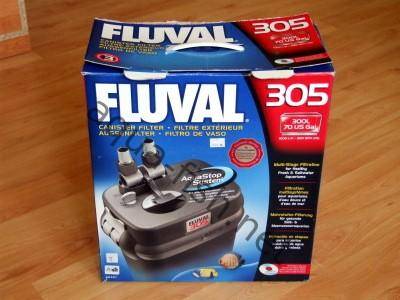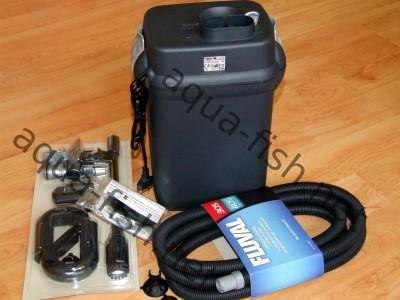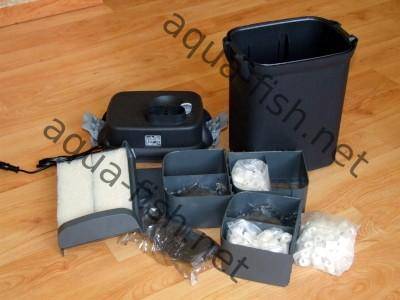
Complete Guide to Aquarium Filters: FAQs and Buying Tips
Quick Navigation – Key Topics
- Filter Families & Brief History (incl. UGF)
- Overview of Internal Aquarium Filters
- Guide to External Filters (Canister & HOB)
- Sponge Filters: When They’re Best
- UV Sterilization: Built-in & Inline
- Flow & Placement: Killing Dead Spots
- How to Choose the Right Filter for Your Aquarium
- Maintenance & Practical Tips
- Frequently Asked Questions about Aquarium Filters
Brief Description
This page is a comprehensive, practical guide to internal, external (canister), hang-on-back (HOB) and sponge filters, with a short history of under-gravel filters (UGF). You’ll find clear rules of thumb for sizing (turnover), media order, and placement to avoid dead spots, plus an easy maintenance plan. For filtration media suggestions, see our media guide. At the bottom, a refreshed FAQ answers the most common real-world problems. Share your experience via the form at the end!
Last updated: September 15, 2025
There isn’t a single “best” filter. The right choice depends on tank size, aquascape, stocking, and the biotope’s preferred current. Internal and external filters can both deliver excellent water quality when sized and placed correctly.
- Lightly stocked / planted tanks: ~4–5× tank volume per hour
- Community tanks / moderate feeding: 5–7× per hour
- High waste (e.g., cichlids, goldfish): 7–10× per hour
Filter Families & Brief History (incl. UGF)
In early home aquaria, the go-to solution was the under-gravel filter (UGF)—a perforated plate under the substrate with uplift tubes driving water through gravel. While simple and still usable in specific setups, modern hobbyists more often choose internal power filters, external canister filters, HOB (hang-on-back) units, or air-driven sponge filters for greater media flexibility, flow control, and easier maintenance.
Advanced systems may also use sump filters for maximum capacity and modularity—especially on large tanks or paludariums.
Internal Filters
Internal filters are compact units attached with suction cups. They often provide two to three media chambers and an impeller-driven pump. They’re ideal for small to medium tanks, for supplemental flow, or where external equipment isn’t practical.
- Media layout (3 chambers): coarse foam (mechanical) → ceramic rings or other biological media → fine foam before the pump.
- Pros: simple install, low cost, safe with kids/pets, good as a secondary flow source.
- Cons: limited media volume, visible in the tank, less suitable for heavily stocked large aquariums.
- Tip: Many internals include an air intake to boost oxygenation. Use flow controls if inhabitants prefer gentler current.
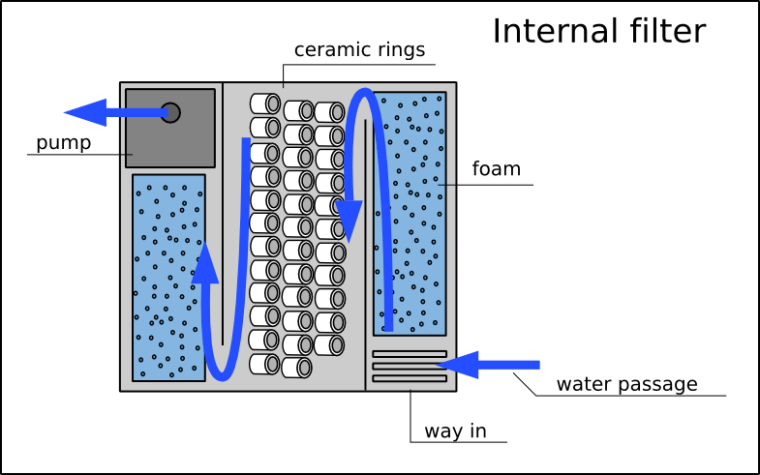
External Filters (Canister & HOB)
External filters move water via inlet/outlet tubing to a sealed media chamber (canister) or a rear-mounted box (HOB). They excel at mechanical and biological performance thanks to higher flow potential and larger media capacity.
Canister (classical external)
- Strengths: large, customizable media volume; quiet; flexible returns (e.g., spray bar); easy to service away from the tank using shut-off valves.
- Watch outs: ensure strainers or pre-filters protect the impeller; check O-rings and quick-connects for leaks; prime per manufacturer’s instructions.
- Recommended media order: coarse pad → fine pad → biological media → (optional) chemical media → outlet.
- Spray bar tip: position just below the surface and angle slightly up to create gentle ripples that prevent surface film.
HOB (hang-on-back)
- Strengths: easy access, compact footprint, good for small to mid-size tanks and newcomers.
- Watch outs: open-top or lid cutout needed; waterfall can be noisy at low water levels; flow is sensitive to water level.
- Use cases: nano to mid-size community tanks, quarantine tanks, and grow-outs.
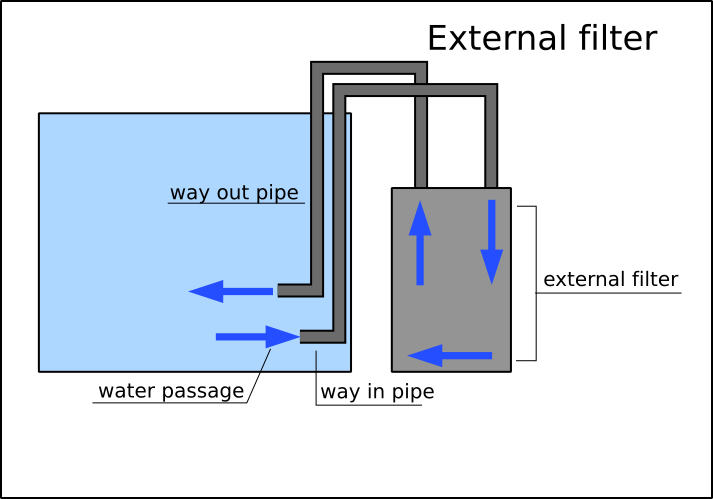
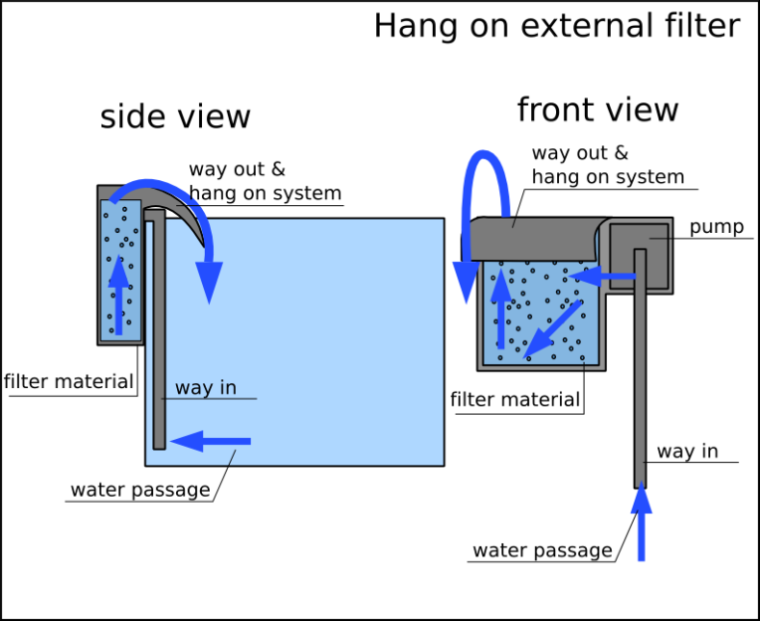
Sponge Filters: When They’re Best
Air-driven sponge filters are inexpensive, gentle, and superb for fry, shrimp, hospital, and breeding tanks. They provide strong biological filtration with soft mechanical polishing and very safe intake.
- Pros: fry-safe, shrimp-safe, low current, easy to seed with bacteria, great oxygenation.
- Cons: rely on an air pump; limited fine mechanical polish compared to canisters/HOBs.
- Tip: Dual-sponge units let you clean one side at a time without crashing bacteria.
UV Sterilization: Built-in & Inline
Some canister filters include a built-in UV lamp, and standalone inline UV sterilizers can be plumbed into the return line. UV targets free-floating organisms in the water column (algae bloom/green water, certain pathogens). It won’t scrub algae from glass or hardscape; think of it as a polishing and preventative tool.
- When useful: recurring green water, high bioload systems, quarantine/hospital tanks.
- Notes: match UV wattage and flow rate; replace bulbs per spec; shield eyes/skin from UV during service.
Flow & Placement: Killing Dead Spots
Place intake low (not buried in detritus) and returns to create a circular path around hardscape. Dead spots collect debris that can fuel algae/cyanobacteria and raise nitrates. Use an internal filter or adjusted spray bar to push flow behind wood/rocks where debris settles.
- Surface ripple = better gas exchange, less surface film.
- Direct hard jets away from delicate plants or slow-water species.
- For long tanks, consider two return points or an auxiliary internal filter to even out flow.
How to Choose the Right Filter for Your Aquarium
- Start with turnover (see box above) then pick the form factor that fits your space and maintenance style.
- Small tanks: internal or HOB (with flow control); sponge for breeding/shrimp.
- Medium–large tanks or high waste: canister (or multiple filters) for media volume and stable flow.
- Over-sizing caution: big pumps can create stressful current—use spray bars, diffusers, or valve down.
- Low water level setups (paludariums/turtles): canisters perform well even with reduced display depth.
- Troubleshooting first: if water quality suffers, verify the tank is fully cycled, stocking is reasonable, and maintenance is consistent before changing hardware.
Maintenance & Practical Tips
- Mechanical media: rinse every 2–4 weeks in old tank water; replace only when degraded.
- Biological media: disturb minimally; never rinse under chlorinated tap water.
- Hoses & impeller: brush-clean monthly/bi-monthly; a rotor clean often fixes noise and flow loss.
- Power safety: switch off before servicing; re-prime per manual; check for leaks and confirm steady flow after restart.
- O-rings: keep clean; use aquarium-safe lubricant to prolong life and prevent drips.
- Pre-filters: sponge over inlets protects pumps and livestock (fry/shrimp) and extends service intervals.
- Downtime limit: avoid leaving media stagnant without flow/oxygen for long periods; if cleaning takes time, keep media submerged in tank water and finish promptly.
Pictures
We are not endorsing any products. The images provided are for informational purposes only.

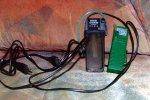
Additional Information: Questions and Answers
We merged legacy answers into a concise, up-to-date FAQ. If you don’t find your case here, use the form at the bottom to ask—we’ll expand this list.
-
What media should I use in a canister?
Stack in this order: coarse pad → fine pad → biological media (ceramic rings, sintered glass, bio balls) → optional chemical media (activated carbon, phosphate remover, etc.). Chemical media are situational—use when you have a reason (odor/tannins, post-medication cleanup).
-
Does carbon remove ammonia?
No. Activated carbon targets dissolved organics, odors, and discoloration (tannins) — and it can also adsorb many medications. Do not run carbon while you’re treating fish: remove it before dosing and keep it out until the treatment is finished. Ammonia and nitrite are removed by your biological filtration once the tank is fully cycled. After treatment, fresh carbon can be used short-term to clear residual meds.
-
How do I size a sponge filter for a 10-gallon tank?
Follow the manufacturer’s ratings. A dual-sponge model is handy—clean one side at a time to preserve bacteria.
-
Do air-driven filters need electricity?
They need an air pump (electric) to run. The filter itself has no motor, but the pump provides airflow.
-
Can I switch the filter off for tank maintenance?
Yes, during maintenance. Keep media submerged in tank water and restore flow promptly. Stagnant media can suffer bacteria die-off if left without oxygenated flow for too long.
-
Where should I place the filter?
HOBs hang on the back; keep water level near their weir to reduce noise. Canisters sit below/behind with intake low and returns arranged to create a circular path and surface ripple. Internals mount inside on glass; aim the outlet to eliminate dead spots.
-
Why is my filter making bubbles or noise?
Likely air being drawn in (low water level, loose fittings) or a dirty impeller. Top up water, reseat hoses/O-rings, and clean the rotor and housing.
-
Which is better: HOB or internal?
HOBs generally offer more convenient maintenance and media flexibility; internals are safer around kids/pets and add targeted flow. Choose by tank size, access, and desired current.
-
When should I replace sponges and other media?
Rinse mechanical sponges regularly in old tank water; replace only when they lose structure. Do not routinely replace biological media—preserve your bacteria colony.
-
Which fish can live without a filter?
Some labyrinth fish (e.g., bettas, gouramis) can tolerate lower oxygen and mild flow, but filtration is still strongly recommended for stable water quality. If attempting low-tech planted systems, ensure adequate water movement and strict maintenance.
-
Why are my nitrites high?
Usually incomplete cycling or overloaded stocking/feeding. Verify the tank is fully cycled, reduce waste inputs, and increase mechanical maintenance.
-
What’s a canister filter?
An external, sealed media chamber connected by hoses. It offers large media volume and customizable stages—great for medium to large aquariums.
-
How can I reduce flow?
Use the unit’s flow control, a spray bar, or a valve (do not over-restrict the intake). For air-driven filters, an in-line valve on the airline works well.
-
What size filter for a 16-gallon (≈73 L) tank?
Aim for 5–7× turnover (≈ 365–510 L/h) in real-world flow. Pick a model whose rated flow is higher to account for media clogging.
-
Why are canisters popular for big tanks?
They hold more media and sustain stable, high-quality mechanical biological filtration with flexible returns that tame current.
-
Where should the water level be relative to the filter?
HOB: keep the water near the spillway to minimize noise and splashing. Canister: ensure inlet remains fully submerged; never run pumps dry.
Copyright note: This article was originally written by Michela Ferretti and has been substantially updated and expanded. Aqua-fish.net holds the full copyright.

